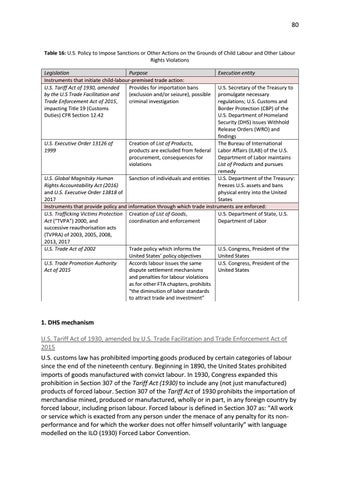80
Table 16: U.S. Policy to Impose Sanctions or Other Actions on the Grounds of Child Labour and Other Labour Rights Violations Legislation Purpose Instruments that initiate child-labour-premised trade action: U.S. Tariff Act of 1930, amended Provides for importation bans by the U.S Trade Facilitation and (exclusion and/or seizure), possible Trade Enforcement Act of 2015, criminal investigation impacting Title 19 (Customs Duties) CFR Section 12.42
Execution entity
U.S. Secretary of the Treasury to promulgate necessary regulations; U.S. Customs and Border Protection (CBP) of the U.S. Department of Homeland Security (DHS) issues Withhold Release Orders (WRO) and findings U.S. Executive Order 13126 of Creation of List of Products, The Bureau of International 1999 products are excluded from federal Labor Affairs (ILAB) of the U.S. procurement, consequences for Department of Labor maintains violations List of Products and pursues remedy U.S. Global Magnitsky Human Sanction of individuals and entities U.S. Department of the Treasury: Rights Accountability Act (2016) freezes U.S. assets and bans and U.S. Executive Order 13818 of physical entry into the United 2017 States Instruments that provide policy and information through which trade instruments are enforced: U.S. Trafficking Victims Protection Creation of List of Goods, U.S. Department of State, U.S. Act (“TVPA”) 2000, and coordination and enforcement Department of Labor successive reauthorisation acts (TVPRA) of 2003, 2005, 2008, 2013, 2017 U.S. Trade Act of 2002 Trade policy which informs the U.S. Congress, President of the United States’ policy objectives United States U.S. Trade Promotion Authority Accords labour issues the same U.S. Congress, President of the Act of 2015 dispute settlement mechanisms United States and penalties for labour violations as for other FTA chapters, prohibits “the diminution of labor standards to attract trade and investment”
1. DHS mechanism U.S. Tariff Act of 1930, amended by U.S. Trade Facilitation and Trade Enforcement Act of 2015 U.S. customs law has prohibited importing goods produced by certain categories of labour since the end of the nineteenth century. Beginning in 1890, the United States prohibited imports of goods manufactured with convict labour. In 1930, Congress expanded this prohibition in Section 307 of the Tariff Act (1930) to include any (not just manufactured) products of forced labour. Section 307 of the Tariff Act of 1930 prohibits the importation of merchandise mined, produced or manufactured, wholly or in part, in any foreign country by forced labour, including prison labour. Forced labour is defined in Section 307 as: “All work or service which is exacted from any person under the menace of any penalty for its nonperformance and for which the worker does not offer himself voluntarily” with language modelled on the ILO (1930) Forced Labor Convention.













